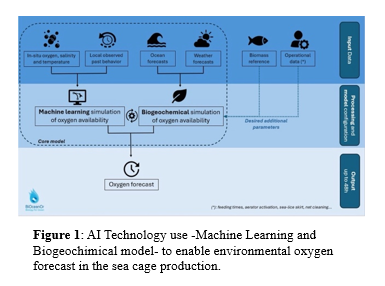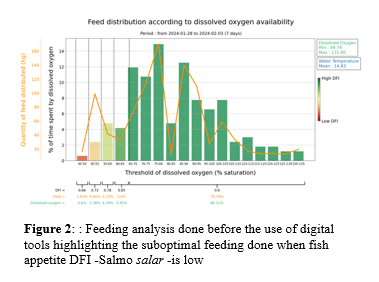IMPROVING SEA FARM SUSTAINABILTY AND EFFICIENCY THROUGH AI TECHNOLOGY AND ENVIRONMENTAL OXYGEN PREDICTION
Introduction
Aquaculture is one of the main levers for feeding tomorrow’s world, but this activity is affected by the global warming and the increase in ocean temperatures , which strongly affect the oxygen level in the water, a key parameter for the fish health and fish appetite -regulated by both temperature and oxygen level-. Oxygen fluctuation will lead to a daily change in fish appetite for Atlantic salmon Salmo salar (Remen 2016), called DFI – Daily Feed Intake - and will affect the operations in the sea, mainly on cage feeding management.
In this context, management support through live environmental data is no longer sufficient, and the predictive need becomes essential to adjust daily decisions, in particular feeding actions, which concentrate the environmental im pact of the activity, through its production -origin of raw materials- and its us e -can be polluting if poorly managed and wasted-.
BiOceanOr’s predictive tools, based on AI and m achine learning from local and external data collection , which help the aquaculture industry by reducing the environmental footprint of activities while maintaining high performance , is one of the solutions to tomorrow’s challenges.
Results
Based on temperature and oxygen prediction (Figure 1) , we can identify the ideal and less opportune windows times for feeding during the next working days, anticipating the best appetite window for fish .
By analyzing farmer’s state of the art, we can estimate how much feed is given into suboptimal period (Figure 2) and asses the margin of improvement. The Figure 2 below illustrates a pre-deployment analysis in Chile, wh ere 21.2% of the feed is given outside the optimal periods, resulting in feed waste, inefficient productivity, economic loss and unnecessary environmental impact.
By adjusting the feeding time based on the prediction , it becomes possible to move from the red-orange suboptimal zone -21,2% feeding- (Figur e 2) to the optimal green zone.
This new feeding management process led to (i ) a redu ction in the amount of fee d not consumed , and improvement in the eFCR of production, (ii) an improvement in the growth performance SGR, by optimising the amount of feed assimilation.
Conclusion
As the cost of feed to the farmer represents up to 70% of the annual expenditure in the salmon industry and in the carnivorous species in general, this marine oxygen modelling in the sea has a specific value proposition to assist the farmers in their day to day operations , helping them to better manage the feeding process . It is a good example of how technical innovation can lead to both (i) a positive environmental impact through less food lost to wildlife, and (ii) an economic gain for the activity through eFCR & SGR improvement.
Discussion and perspective
The tool has been developed through two main innovations, (i ) oxygen prediction capacity (Figure 1) and the (ii) specific knowledge of the Atlantic salmon -Salmo salar- metabolism . The application to other species is a new challenge, as the effects of global warming are strongly observed in the Mediterranean Sea , where the temperature each summer is approaching the maximum tolerance threshold for commercial fish such as sea bass -Dicentrarchus labrax - and sea bream -Sparus aurata-, and where the improvement could be much higher than what we use to observe with the Atlantic salmon.
Keywords:
Precision Aquaculture
Sustainability
Machine Learning
Artificial Intelligence
Feeding Management
Performance Optimisation
Footprint reduction
Economical Savings
Animals Welfare



